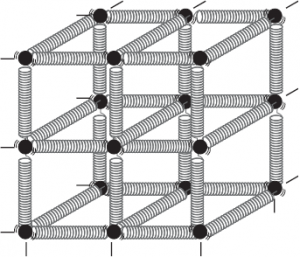Elastic Behaviour of Solids

The property of the body because of which they are able to come back to their original status after removing the external force applied is called elasticity.
In a solid, each atom or molecule surrounded by neighbouring atoms or molecules. These are bonded together by inter atomic or intermolecular forces and stay in a stable equilibrium position. When a solid is deformed, the atoms or molecules are displaced from their equilibrium positions causing a change in inter atomic (or intermolecular) distances.
When the deforming force is removed, inter atomic forces tend to drive them back to their original positions. Thus the body regains its original shape and size. The restoring mechanism can be visualized by taking a model of spring – ball system shown in the figure below. Here the balls represent atoms and springs represent inter atomic forces.
If you try to displace any ball from its equilibrium position, the spring system rises to restore the ball back to its original position. Thus elastic behaviour of solids can be explained in terms of microscopic nature of the solid. Robert Hooke, an English physicist performed experiments on springs and found that the elongation produced in a body is proportional to the applied force or load.
Elastic body: A body that returns to its original shape and size on the removal of the deforming force (when deformed within elastic limit) is called elastic body.
Actually, this concept of an elastic body is an idealization and no materials behave as perfectly elastic. A quartz fibre is the nearest approach to a perfectly elastic body. Thus, all bodies are elastic, the difference lies only in degree.
Elasticity: The property of matter by virtue of which its regains its original shape and size, when deforming forces have been removed is called elasticity.
Contrary to the concept of elasticity in daily life, in physics elasticity stands for opposition to change. Quantitatively, more rigid a body, more elastic it is said to be. For this reason, steel is more elastic than rubber.
Thus a solid can be imagined to have n number of springs attached to each of the atoms in 3 – D and vibrate simple harmonically about the mean position, when a force is applied.
Applications of Elastic behaviour of solids:
- Lift and cranes have to support heavy loads, therefore the suspension ropes and cables should have very high strength. Material having higher young’s modulus are used in selecting the ropes in lifts and trains.
- Principles of elasticity are used to select materials in the construction of bridges and building.
- The principle of elasticity is also used in measuring the height of mountains.
- Metallic machinery are not subjected to stress beyond its elastic limits, otherwise they will be deformed permanently.
